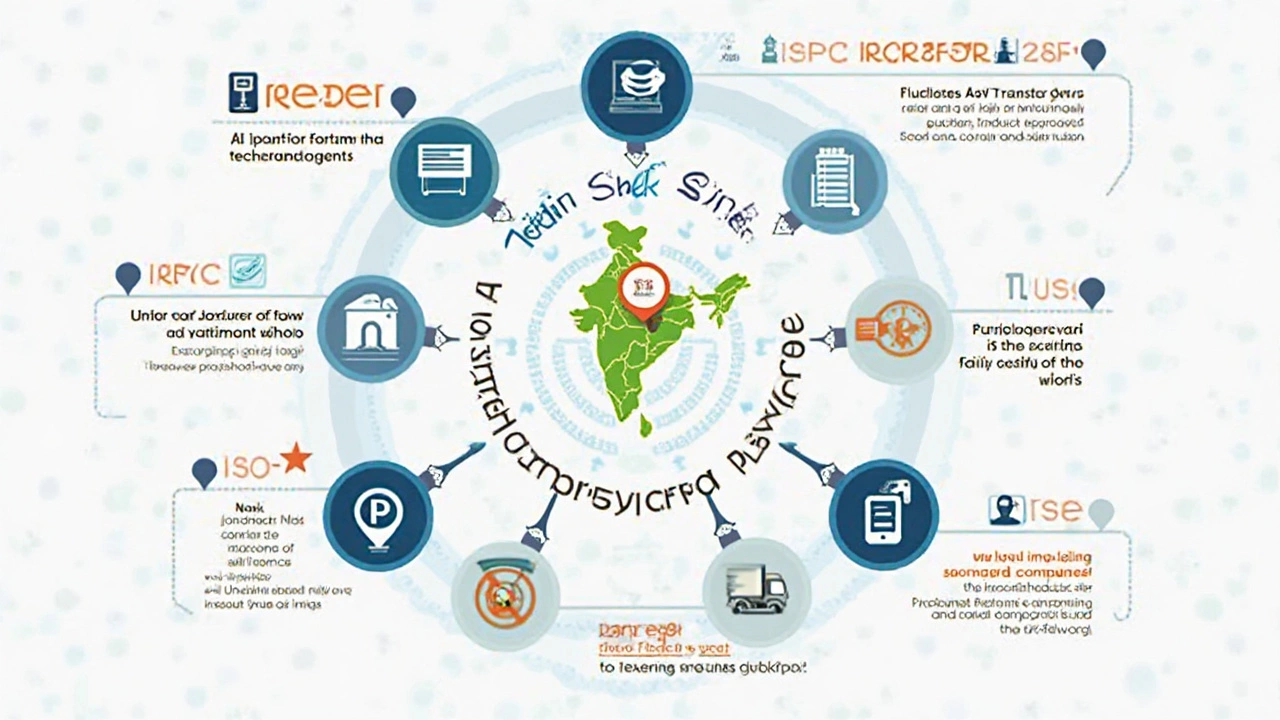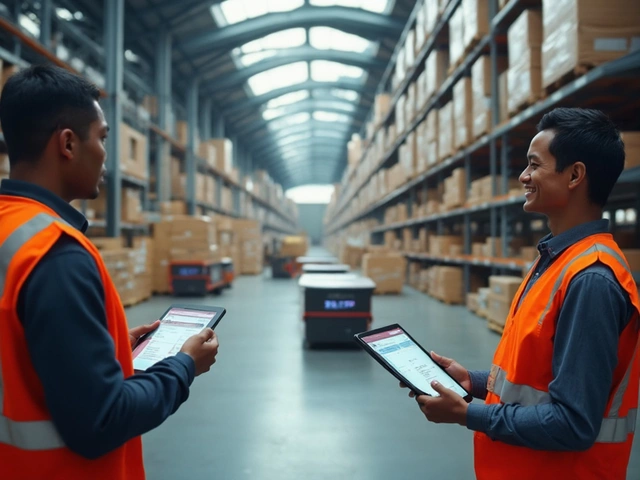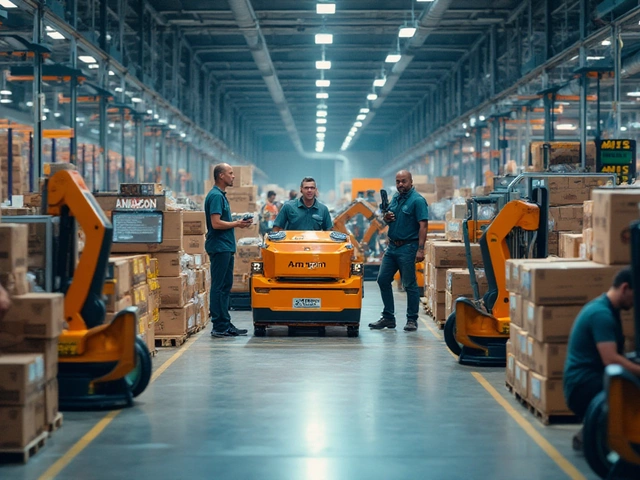Ever wonder how FedEx Freight manages to deliver packages seamlessly across the globe? It’s all thanks to some pretty sophisticated software! Picture this: coordinating thousands of shipments efficiently needs more than just human effort; it requires brains behind the scene, aka software, working hand-in-hand with their teams.
Let's start with the transportation management systems (TMS). This software handles freight movement like a well-oiled machine, tracking routes, monitoring cargo, and even suggesting the best paths to take. It’s not just about knowing where a package is; it's about optimizing the journey from start to finish.
Then there's warehouse management, which is as exciting as it sounds. Among FedEx's secret weapons are automation and robotics that keep the packages moving without a hitch. Imagine robots sorting your parcels while you sleep!
- The Role of Software in Logistics
- Transportation Management Systems (TMS) at FedEx
- Warehouse Management Innovations
- Robots and Automation Technologies
- Software for Customer Experience
- Tips for Businesses Using Logistics Software
The Role of Software in Logistics
Software is the unsung hero in logistics, a sector that depends on precision and timeliness. In the world of FedEx Freight, it's not about just moving packages; it's about doing it smartly and efficiently. Ever thought about what goes on behind the scenes? A lot of heavy lifting is actually done digitally.
Let’s break it down. At the heart of logistics, software ensures that every package gets from Point A to Point B in the shortest time possible. This is where transportation management systems (TMS) come in—they’re like the air traffic control for freight, managing routes, shipments, and schedules.
Data analytics play a massive role too. By crunching numbers, logistics companies can foresee potential hiccups and adapt quickly. For instance, if there's a storm brewing that might delay deliveries, the right software can reroute shipments to avoid disruptions.
Integration with Modern Technologies
In today's tech-savvy world, logistics software integrates with advanced systems like IoT devices and GPS tracking to give real-time updates on shipments. Imagine knowing exactly where your package is at any given moment—that’s peace of mind both for businesses and customers.
Plus, software isn't just about route tracking; it also facilitates better inventory management. By using warehouse management systems integrated with robotics, companies can monitor stock levels, optimize storage, and speed up order fulfillment.
Enhancing Customer Experience
The icing on the cake? Software is key to elevating customer service. With automated updates and communication channels, customers feel more connected and informed. Ever received a shipping update on your phone? That's software doing its magic, letting you know exactly when your package will arrive.
The logistics world is a fast-paced, dynamic arena, and software is the backbone supporting it all. Whether you're a business or consumer, you're riding the wave of tech innovations that make shipping smoother and faster than ever.
Transportation Management Systems (TMS) at FedEx
When it comes to logistics, you can't overlook the mighty power of a transportation management system. FedEx Freight uses a robust TMS to keep everything moving smoothly. It's like the GPS for freight, guiding each shipment efficiently from point A to B, and sometimes even to C.
Real-time Tracking
One standout feature of FedEx's TMS is real-time tracking. Ever wondered how you can check your package's status at any time? That's TMS magic. This system allows FedEx to provide updates that are almost as fresh as the morning news.
Optimizing Routes
Route optimization is where FedEx really hits it out of the park. Their TMS analyzes traffic patterns, weather conditions, and tons of other data points to find the best routes. This isn't just about speed; it's about efficiency, saving fuel, and cutting down on emissions.
According to IndustryWeek, "FedEx's transportation management system has significantly reduced delivery times and operational costs."
Integration with Other Systems
A great TMS doesn't stand alone; it plays well with others. FedEx's system integrates seamlessly with their warehouse management software, ensuring smooth handoffs and reducing the chance of human error. This means fewer headaches and happier customers.
And if you’re into numbers, check this out: FedEx Freight's implementation of TMS led to a 15% reduction in transit times on average. That's a big deal in the logistics world.
Benefits for Businesses
If you're a business thinking of leveraging such technology, consider the benefits. A TMS can help with everything from shipping cost analysis to automated reporting. It's the kind of tool that keeps businesses on track and competitive.
FedEx Freight's use of a transportation management system is a testament to how far logistics software has come. It’s not just about moving freight anymore; it's about moving it smarter, better, and faster.
Warehouse Management Innovations
FedEx Freight's warehouses are nothing short of futuristic. When it comes to handling millions of packages, relying on humans alone just won't cut it. That's why FedEx Freight has embraced automation in a big way. It's like something out of a sci-fi movie!
Robotics in Action
One of the coolest innovations is the use of robots in their warehouses. These bots do the heavy lifting – literally. They can move packages quickly and accurately, reducing human errors and speeding up processes. Imagine a team of robots cruising around, sorting parcels faster than you can say 'logistics'.
Inventory Management Software
Speaking of speed and accuracy, they have advanced inventory management systems that keep track of everything. Ever wonder how they always seem to know exactly where your package is? It's because their software is continuously updating locations, inventory levels, and logistics status in real-time.
Data-Driven Efficiency
Data plays a huge role. Just like your health app tracks steps, their systems track performance metrics. How long does it take for a package to move from one point to another? How can they cut down that time by even a few seconds? By analyzing this data, they improve efficiency constantly.
Let's talk numbers for a sec. A report showed that warehouse automation can improve efficiency by up to 25%. And when you're shipping millions of packages, those percentages add up to big time savings!
| Innovation | Impact on Efficiency |
|---|---|
| Robotics | Reduces manual error and speeds up sorting |
| Inventory Software | Real-time tracking and updates |
| Data Analysis | 25% improvement in warehouse efficiency |
If you're in the logistics business or just fascinated by tech, watching how FedEx Freight utilizes these innovations is both inspiring and a little mind-blowing. Next time you receive a quick delivery, remember there's a robot and a load of data working hard behind the scenes.

Robots and Automation Technologies
When you think about the magic behind FedEx Freight operations, it's hard not to imagine robots whizzing around like in a sci-fi movie. These aren't just figments of imagination; FedEx Freight uses state-of-the-art robotics to ensure efficiency and reliability in their logistics.
The heart of their operation lies in automated sorting systems. These robots speedily handle numerous packages daily, reducing human error and ensuring packages are accurately processed. Imagine machines that can sort and move thousands of boxes in just an hour – pretty impressive, right?
Sorting and Handling
The robotic arms and conveyor belts used in FedEx hubs perform tasks that would be too labor-intensive for humans. This automation slashes the time taken to handle each package, allowing freight management to be more precise and scalable.
Benefits Beyond Speed
It's not just about speed, though. These technologies also enhance safety. With robots performing physically demanding tasks, human workers face fewer risks related to manual labor.
Investment and Innovation
FedEx has been investing heavily in developing such capabilities. A significant chunk of their budget is earmarked each year for research and development in automation, positioning them as leaders in shipping technology.
| Robotics Feature | Benefit |
|---|---|
| Automated Sorting | Increases package processing speed |
| Predictive Maintenance | Reduces downtime with proactive repairs |
| Collaborative Robots | Enhance human-robot teamwork |
Looking ahead, FedEx Freight plans to integrate even more sophisticated AI into these systems. This means taking automation to new heights, providing insights not just on immediate operations but predicting future shipping trends.
For businesses pondering investing in similar tech, it's worthwhile considering factors like scale, cost, and customization according to industry needs. In a nutshell, as logistics software evolves, companies like FedEx Freight are setting the benchmark on how to blend technology with human efficiency seamlessly.
Software for Customer Experience
When it comes to logistics, customer experience might not be the first thing you think of, but it’s a biggie! FedEx Freight knows that happy customers are loyal customers. So, they use specialized software to make every stage of the shipping process smoother for their clients.
First off, FedEx Freight puts a lot of effort into real-time tracking systems. This software lets customers know where their packages are at any given moment. Whether you’re shipping a gift or a critical business part, knowing your delivery status gives peace of mind.
And then there's the FedEx Delivery Manager interface. It's a game-changer! This online tool allows users to customize their deliveries. Need to reschedule or reroute? No problem. The software gives customers control over when and how they receive their packages, showing just how much FedEx thinks about user convenience.
Enhanced Communication Channels
FedEx Freight’s software also boosts communication. With automated alerts and notifications sent via SMS or email, customers stay in the loop about any delays or changes. This level of transparency builds trust and ensures customers aren’t left guessing.
Furthermore, the software integrates customer feedback using AI-driven analytics. This nifty tool collects reviews and sorts through customer comments to spot patterns. It’s a fantastic way for FedEx to know what’s working and what needs fixing.
Data-Driven Insights
The role of data cannot be overstated. FedEx analyzes tons of data collected through their software to enhance the customer experience. They study delivery patterns, customer preferences, and seasonal trends to tweak their services, ensuring satisfaction remains high.
| Feature | Customer Benefit |
|---|---|
| Real-time Tracking | Peace of mind with package visibility |
| FedEx Delivery Manager | Control over delivery time/location |
| Automated Alerts | Timely updates on delivery status |
FedEx Freight is setting the bar high with its software solutions aimed at enhancing the customer experience. These tools aren’t just about getting packages from A to B. They’re about delivering satisfaction at every step.
Tips for Businesses Using Logistics Software
So you're thinking about implementing logistics software for your business? Smart move! Embracing technology like logistics software can completely transform how you manage operations, from tracking packages to optimizing supply chains.
1. Find the Right Fit
Your business is unique, so your software should be too. Research different logistics software tools to find one that matches your specific needs. Whether it's a full-fledged Transportation Management System (TMS) or something more basic, make sure it aligns with your operations.
2. Train Your Team
Just having great software isn't enough—your team needs to know how to use it effectively. Invest time in training so they can leverage all the cool features your logistics software has to offer. This might need a couple of training sessions, but trust us, it's worth it.
3. Keep Customer Experience in Mind
At the end of the day, you want to make your customers happy. Many logistics solutions offer features that improve customer experience, like real-time shipping updates and streamlined service requests. Be sure to explore and activate these features to keep your clients smiling.
4. Leverage Data
Today’s logistics software generates a wealth of data. Use these insights to tweak your operations for better efficiency. For example, analyze shipment logs to identify delays or issues, and adjust accordingly.
5. Think Long-Term
Consider the scalability of the software. As your business grows, you'll want a system that grows with you. Check if your chosen platform supports additional features or integrates with other systems you might need in the future.
Ready to take the plunge? Modern logistics software isn't just about keeping up with competitors, it's about pushing your business to the next level. Armed with these tips, you’ll be well on your way to shipping success!





